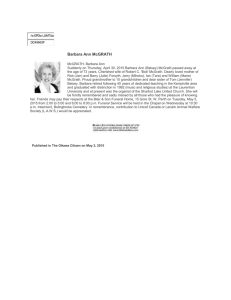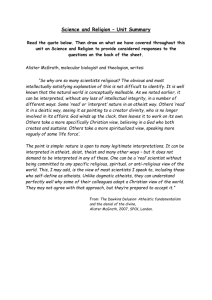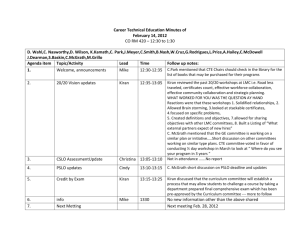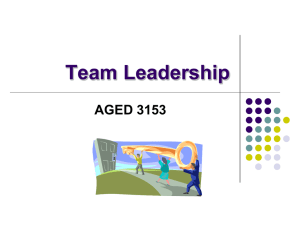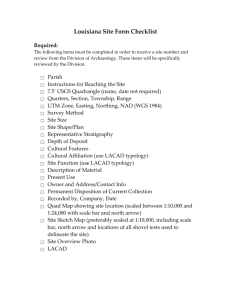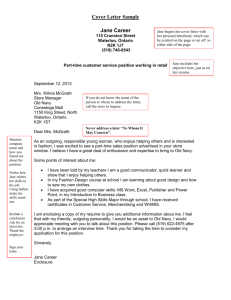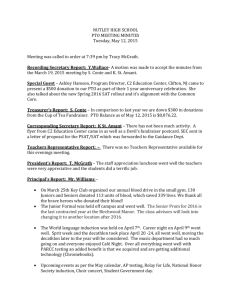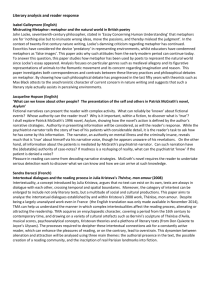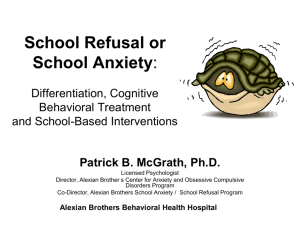Essay Title - Microsoft Research
advertisement
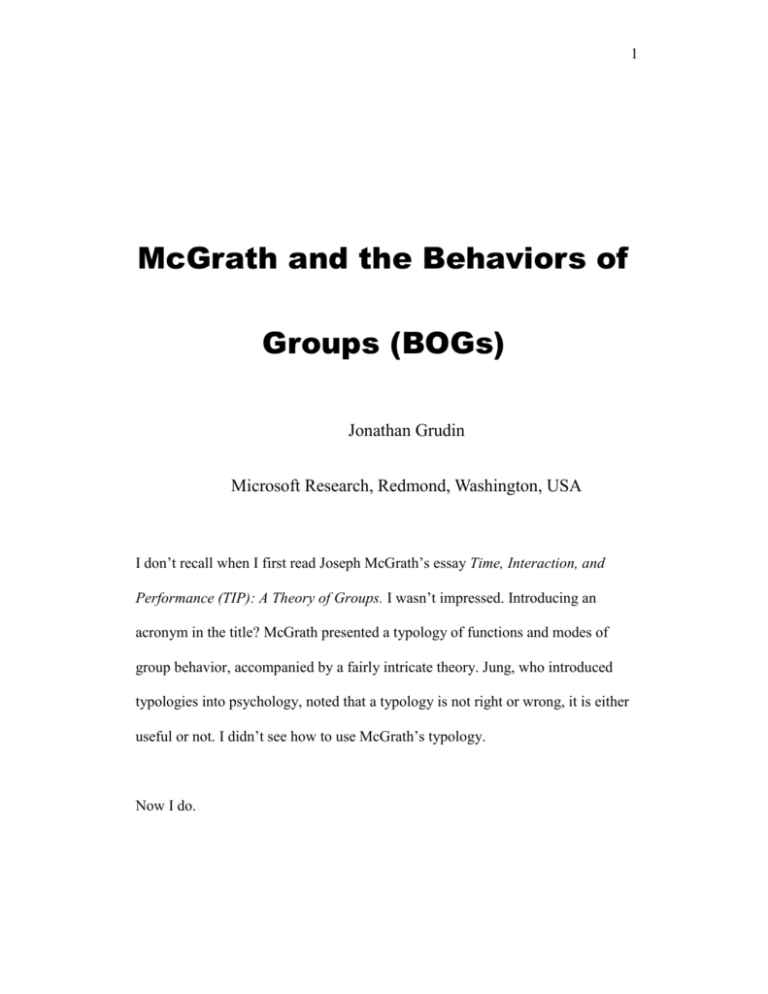
1 McGrath and the Behaviors of Groups (BOGs) Jonathan Grudin Microsoft Research, Redmond, Washington, USA I don’t recall when I first read Joseph McGrath’s essay Time, Interaction, and Performance (TIP): A Theory of Groups. I wasn’t impressed. Introducing an acronym in the title? McGrath presented a typology of functions and modes of group behavior, accompanied by a fairly intricate theory. Jung, who introduced typologies into psychology, noted that a typology is not right or wrong, it is either useful or not. I didn’t see how to use McGrath’s typology. Now I do. 2 A Summary of McGrath’s Article Writing in 1991, McGrath noted that prior to the 1980s, research into group behavior relied on controlled study of small groups formed for the experiments. Such groups were typically ephemeral, with fixed membership, no past or future, and little freeloading. A group was given a single task and all necessary resources. Although the approach conformed to a reductionist model of experimental hypothesis-testing, McGrath argued that the results had little bearing on the rest of the world. Such experimental studies of artificial groups absorb tremendous energy to this day. They can identify phenomena to look for in naturally occurring settings, but McGrath’s discussion is a healthy reminder that they prove little. However, his purpose was not to beat up on this tradition, and the value of his essay lies elsewhere. McGrath shifted focus to in vivo observations and studies to develop a typology and theory of behavior in what is often called “the real world.” 3 Production Group Well-Being Member Support Inception Production demand Interaction demand Inclusion demand and and opportunity and opportunity opportunity ProblemSolving Technical problem- Role network solving definition Conflict Policy resolution Resolution Execution Performance Position and status attainments Power and payoff distribution Contribution and payoff distribution Interaction Participation Figure x.1. Group modes and functions (McGrath, 1991). McGrath built on Hackman (1985) to create the typology reproduced in Figure 1. Project teams or groups engage in four critical modes of operation: inception, problem-solving, conflict resolution, and execution. Inception encompasses the activities around taking on a project. Groups re-experience this mode when they take on new projects over time. Execution comprises the activities directly related to project goals. Problem-solving and conflict-resolution cover tangential activities that may arise along the way. (When problem-solving or conflict-resolution is the task, incidental problems or conflicts trigger these modes. For example, in Spike Lee’s bank heist turned hostage negotiation film Inside Man, the law enforcement agents played by Denzel Washington and 4 Willem Dafoe are in conflict resolution mode when quarreling over tactics and in execution mode when quarreling with the hostage-takers.) Each mode comprises activities in support of three functions: production, group health or well-being, and member support. Production activities focus directly on getting on with the project. Group well-being is the goal of a morale event to build empathy and trust among team members, for example. Promotions help insure that members get what they need as individuals. To see the difference between group health and member support, consider a team that works together well but breaks up because one member can’t afford to continue participating, and another team, such as a successful but dysfunctional rock group, pulled apart by animosities despite everyone being personally rewarded. Non-production functions are not directly tied to a group’s task, but in the long run they contribute to accomplishing it. Over half of McGrath’s essay and ten of its twelve propositions elaborate TIP, a “theory of groups” focused primarily on temporal aspects of project activity: how we schedule and synchronize work, match activities to available time, manage task duration ambiguity and conflicting priorities, handle commitments and deadlines, address assignment inequities, and so on. For example, a team that takes on a highly familiar type of project can move from inception to execution with negligible problem-solving or conflict resolution. 5 McGrath regarded TIP as his principle contribution, but I find the typology more broadly useful. The Typology “At any one time, a group will be engaged in activities… having to do with all three contribution functions.” This statement is the key, although on first encounter it seemed an exaggeration. I came to understand it to mean that although a group may avoid a mode of interaction, it cannot avoid attending to all three functions. This is important to emphasize because activities that address group well-being and member support are easy to overlook. In fact, it’s difficult not to overlook many of them. Our ancestors lived in groups for millions of years. Like perceptual and cognitive behaviors that are shaped by genes interacting with environment, our innate social behaviors don’t require conscious attention. We constantly, intuitively address status, motivation, and other aspects of group health and member support. Some people are more skilled at it than others, but even skill is largely unconscious. Not only are these activities taken for granted, discussion of them may be avoided, such as status concerns in cultures that emphasize egalitarianism. As a result, we don’t see or understand effects of technological and behavioral innovation on these activities, leading to many a unsuccessful outcome 6 and misunderstanding of why failure occurred. To address this, it’s advisable to assume that group well-being and member support activities are always present— even when group members are sleeping!—and look for them. Consequences of Ignoring the Typology A rational approach to supporting project activity is to ask “what are these people trying to do and how can we help them?” Unfortunately, this leads to an exclusive focus on the Execution mode of the Production function: Performance. How can we increase the rate of production, reduce errors, increase quality? Attention fixates on the lower left cell in Figure 1. This is often reflected in an obsessive concern with metrics and proof of ROI, return on investment (Grudin, 2004). Of course, when we are marketing or introducing an innovation, we would like to know that the effect on performance will be positive, but it’s often impossible to tease out short-term effects of a change, much less subtle long-term effects. Too often, the result is a grim combination of grasping for straws, wherein flimsy data are taken out of context and exaggerated, and looking under lampposts because the light there is better, measuring anything that can be measured easily whether or not it is of great significance. 7 Examples Many experiments were undertaken in vain efforts to show measurable benefit from adding video to audio in distributed problem-solving groups. These experiments focused on performance measures, the lower left cell. Then Williams (1997) found evidence that video is consulted more when groups are in conflict situations or are not native speakers of the same language, activities in two of the other production cells. Also, studies reported that participants liked video, which could contribute to group well being and/or member support, with positive longterm consequences for real groups. (Poltrock & Grudin, 2005). Electronic meeting rooms (also called group decision support systems or group support systems) show remarkable performance benefits in controlled studies, yet after decades of research and fifteen years of commercial availability, adoption is minimal. Why? Consider this example from Nunamaker et al. (1997): “The founder of a very successful medical technology firm called together key personnel from multiple levels in the organization for a GSS session. Thirty minutes into the meeting he turned red in the face and stood up. Pounding a fist on his PC for emphasis, he shouted, "I want to know who put in the comment on the problem with the interface for the new system. We're not leaving this room until I know who made that statement!" He glared around the 8 room waiting for a response. Everyone greeted his outburst with silence. (The founder then terminated the meeting.)” This executive had been convinced that the technology would improve performance, but the potential loss of status from being openly challenged was more important to him. In general, effective use of these systems often requires a behavioral facilitator and a technician, who become a focus of attention at the expense of the organizer. Enhanced performance comes at the expense of activities in other cells. (See Dennis & Reinicke, 2004). I’ve seen managers try new technologies that they believed would increase productivity or enhance their status as innovators, but a manager who appeared helpless in the face of a breakdown would not try a second time. Another example is workplace use of instant messaging. Measurable time savings from use may be far too little to build a case for the technology, but the pleasure of quick yet minimally intrusive interaction can serve non-production functions that ultimately serve the group and organization. The Theory TIP details could be useful as social psychology or in designing workflow or other complex group support systems, but first-time readers might prefer to skim 9 the theory lightly and spend more time thinking about the typology. The theory won’t appeal if the typology doesn’t. Those more familiar with natural sciences might approach TIP advised that in the social sciences, “theory” can be interpreted broadly. Natural sciences followed a path from description to identification of patterns, and then, often centuries later, came useful theory. Social science is in more of a hurry. Erickson (2000) is an elegant, humorous critique of the use of theory. Centuries of observations of animals preceded Linnaeus’s taxonomy and conceptual hierarchy. Much later came Darwinian theory. Similarly, centuries of identifying elements preceded Mendeleyev’s periodic chart. Later came Bohr’s model and theory of atomic structure. Centuries of celestial observations and identification of patterns, culminating in Brahe’s meticulous records, made possible Kepler’s theory of planetary motion. Premature theorizing, in the form of religion, alchemy, and astrology, was as likely to impede understanding as it was to advance it. For example, Linnaeus’s theory was that he was elucidating the mind of a Creator. Only when a science is mature is hypothesis-testing the best approach, and even then it is not the only approach. In studies of technology and behavior, descriptive science and a search for patterns are probably most useful today. Patterns are not theory: Physicists constructed cloud chambers to find patterns in particle paths, yet a huge gap separated patterns and theory. But we may feel that to resemble natural sciences, 10 we must have theory, even when, like McGrath, we manage to avoid controlled hypothesis-driven studies. So we stretch the definition of theory. For example, in Grounded Theory, a theory is never right or wrong. It is measured by how well it fits existing data. It may be adjusted given new observations. This seems like descriptive science with identification of patterns and creation of concepts, as practiced by Linnaeus and Mendeleyev. I think something like it is just what we need. It could be considered pre-theoretical, but if we must call it theory to obtain academic respect, OK by me. Social science also has more ambitious theory, which runs the risks encountered by the alchemists and astrologers: acclaimed in their time but poorly regarded later on. McGrath’s theory is not ambitious. He identifies patterns of activity in group projects. It’s fine, but for most purposes, the typology and the emphasis that all three functions are continually being addressed are a great prism through which to view much research and practice. Conclusions Researchers, designers, and acquirers of new technology: Avoid being swept exclusively into the lower left cell. You can’t support activity in every cell, but at least briefly consider each one. Might your envisioned application disrupt activities in some cells? For example, could anonymous brainstorming undermine credit for ideas that is important to some participants? Also, recognize that it may 11 be difficult to support activities in some cells: Voting mechanisms for resolving conflicts or “I’m confused” indicators to register member distress have not proven to be as useful as hoped. We may prefer to communicate agreement or uneasiness in less overt ways. For those concerned with assessment, be wary of exhortations to adopt metrics, especially if only performance is to be measured. Examine “proofs of ROI” critically. Any group activity can be viewed through McGrath’s prism. For example, to the traditional conference functions of community-maintenance and member support, highly selective conferences such as CHI add a production function that was formerly the role of journals. Are group health and member support enhanced by high rejection rates that benefit the lower left cell? References Dennis, A.R. & Reinicke, B.A. (2004). Beta versus VHS and the acceptance of electronic brainstorming technology. MIS Quarterly, 28, 1, 1-20. Erickson, T. (2000). Theory theory: A designer’s view. http://www.visi.com/~snowfall/theorytheory.html Grudin, J. (2004). Return on investment and organizational adoption. Proc. CSCW 2004, 274-277. Hackman, J.R. (1985). Doing research that makes a difference. In E.E. Lawyer, A.M. Mohrman, S.A. Mohrman, G.E. Ledford, T.G. Cummings & 12 Associates (Eds.), Doing research that is useful for theory and practice. Jossey-Bass. McGrath, J. E. (1991). Time, interaction, and performance (TIP): A theory of groups. Small group research, 22, 2, 147-174. Nunamaker, J., Briggs, R.O., Mittleman, D.D., Vogel, D.R. & Balthazard, P.A. (1997). Lessons from a dozen years of group support systems research: A discussion of lab and field findings. Journal of MIS, 13, 3, 163-207. Poltrock, S.E. & Grudin, J. (2005). Videoconferencing: Recent experiments and reassessment. Proc. HICSS-38, CD-ROM, 10 pages. Williams, G. (1997). Task conflict and language differences: Opportunities for videoconferencing? Proc. ECSCW 97, 97-108.
